More retailers are going live
See how small shops are turning views into sales

Small business, big sting. SMBs are feeling the impact of import duties more sharply than large retailers and manufacturers with greater bargaining power and capital reserves. The National Retail Federation recently gathered small retailers to hear what issues they’re facing. We also look at why Americans are embracing resale, how a floral café owner overcame adversity and Meta’s Gen Z insights.
Also this week, retail personality Christos Garkinos shares his live selling playbook. Let's get started.

Gwyneth goes mass. The celebrity lifestyle maven’s Goop links with Westin Hotels & Resorts to offer sleep and wellness tips.
Resale goes mainstream. Americans are discovering the joy and practicality of shopping second-hand.
Uber’s lost & found. Viking drinking horn, Dyson Airwraps and Aritzia Superpuffs are some of the unusual items riders leave behind.
Concert ticket inflation. Here’s why it costs so much to go to a concert.
Microseries, the new miniseries. TikTok spawns an even shorter form of serial entertainment, “The Group Chat” from creator Sydney Jo.


How an iPhone, Instagram, and a story built a resale empire
Retail personality Christos Garkinos, founder of the live selling network Covet By Christos and author of a new memoir, Covet the Comeback, tells us how an Instagram DJ inspired him to go live, and why any SMB retailer with an iPhone and a story to tell should take a page out of his playbook. –Marcy Medina
What is Covet by Christos and what was your journey from brick-and-mortar retailer to live selling?
Covet by Christos is an amalgam of my experience on HSN (Home Shopping Network) and Bravo, me being comfortable on camera and resale being back. In 2018, I began my trunk show business, reselling luxury goods in smaller markets without access. In February 2020 I had my biggest month yet, then the pandemic occurred. No one could travel. I saw DJNice on Instagram Live and thought, “This is how I’m going to do it.” It was March 23, 2020, and I had eight people watching me: two were family, two were friends and the rest were bots. But every night at 5 p.m. I would just show up. I started connecting with viewers, bringing on celebrity friends and it started growing. Friends with stores that had closed came on. When someone asked me in December 2020 what I charged to be on, I thought, “Oh my God—I am the network. I am the HSN of pre-loved luxury goods.” We now do 400 hours of programming a month, I do about 20% of that, and we just hit $125 million in sales since launching.
What should a retailer have in their live selling tool kit?
I still have an iPhone 12! All I need is a little tripod and my camera and some internet. Get a ring light on Amazon. And you want a background that is clear. No clutter. If you’re selling clothes, make sure you have a model. If you’re selling single things, measurements are so important to put in the listing.
What should they do once they’re ready to go live?
As a retailer, you are putting on a show every day. You gotta be entertaining. Think Watch What Happens Live meets HSN. If you’re not comfortable on camera, find someone who is. Themes are always great. Give them exclusive content; if you get new stock in on Monday, Tuesday they will see it live before anyone else does. Early adopters will be your biggest ambassadors. And you just need the right people watching, you don’t need a ton. Our sweet spot is 200-300 viewers.
What’s next for you?
We have meetups with customers all over the world called ChristosCon, and our next one is in Dubai. We’re looking at expanding on WhatNot and TikTok and developing our own app. I’d love to do more public speaking, and my book is laying the groundwork for that. It’s all about how you pivot.
Above: Christos Garkinos. (Courtesy of Rutvik Katuri)

Small businesses likely to take brunt of tariffs
As trade policy swings wildly, costs rise and uncertainty dampens consumer confidence, small businesses are getting vocal about the challenges they’re facing. Raw materials, shipping and labor costs are increasing while the number of shoppers is contracting, putting the squeeze on retailers who are just starting to recover from the pandemic. Without the buying power to negotiate with trade partners and less cash in reserve, smaller retailers are in more peril than their larger counterparts.
Why this matters: As one boutique owner put it, “I feel like it’s stupid to get all wrapped up and worried and make changes in my business when I don’t even know what’s going to happen.” But she’s noticed that store traffic has slowed dramatically since tariffs were announced. Even if you keep steady at your business, consider how consumer behavior may be changing. (Retail Dive)
NRF panel highlights SMB’s economic, policy struggles
The National Retail Federation recently gathered small business owners in a panel at its Retail Innovation & Impact Conference, where they shared what challenges they are already dealing with in the wake of the new administration’s policy changes. Those with many SKUs find it difficult to gauge each tariff and how it will affect each product, making Q4 planning impossible. Others trying to find domestic alternatives are told they will cost three to four times as much as Chinese-made ones. Some are running out of margins to absorb cost increases, and fear having to raise prices on their customers. And others have to come up with extra cash to pay customs before their goods are released.
Why this matters: The organization is urging members to take action and reach out to their Congressional representatives and encourage them to collaborate with the White House to scale back tariffs and provide consistent policy. Telling lawmakers how tariffs affect your job, your store and your community will amplify the voices around small business struggles. (NRF)

Consumer spending bounced back in March
But shoppers may have been stockpiling pre-tariffs
That’s amore: Prada acquires Versace for $1.4B
Amazon CEO thinks sellers will pass tariff costs to customers
Shopify teams should consider AI before hiring someone

Sweet smell of success: Floral café blooms after adversity
On a recent episode of "Small Business Callout," a new series within The Mentor With Mark Bouris podcast, The Real Florist owner Renee Williams got real about the challenges she’s overcome. What began as a side hustle doing flowers at friends’ weddings became a floral delivery service run out of her garage during the pandemic, then blossomed into a floral shop and café that’s now five years old. But when an employee suffered an injury at work, the insurance fallout nearly destroyed the business, forcing her to implement solid SOPs. With the cost of goods on the rise, she found more local growers and new revenue streams, providing floristry education in addition to retail and events.
"I was doing friends’ weddings on the weekends... and it kept going to the point where I was doing 30 weddings a year as my side hustle. I thought, 'This isn’t a side hustle anymore. This is a full-fledged business and I can really provide something to people I love that they are looking for.'" - Renee Williams, The Real Florist
Why this matters: Williams faced adversity as an owner/employer, but credits guidance from her accountant with making her a better businesswoman. Listen to the podcast here.

Meta’s tips on how to market to Gen Z
Meta just released a report, “Generation Zeitgeist: Taking the Social Pulse of Gen Z” that breaks down how they use Facebook and Instagram and how retail marketers can tailor their approach for these shoppers with an annual household income that’s 50% higher than that of Boomers at the same age. For Gen Z, sharing content is a much easier way to connect than text-based conversation; 67% have shared video content from Meta with family and friends. Short-form video (SFV), in particular, is easy to consume and share, and one of the best ways for them to discover new brands and products. They welcome repeat exposure before purchasing, underlining the importance of aggregate attention.
Why this matters: There are nuances in Gen Z’s social media behaviors and preferences. Eye contact and human presence is desired in creative, content should be fluid between platforms and craft creators can tell more innovative stories. To drive purchases, build repeated exposure across platforms and find a wider audience that might be interested in buying versus focusing only on those looking to buy now. (Facebook)

Thanks for reading this week's edition!
You can reach the newsletter team at theskupe@mynewsletter.co. We enjoy hearing from you.
Interested in advertising? Email us at newslettersales@mvfglobal.com
The SKUpe is curated and written by Marcy Medina and edited by Bianca Prieto





Comments ()